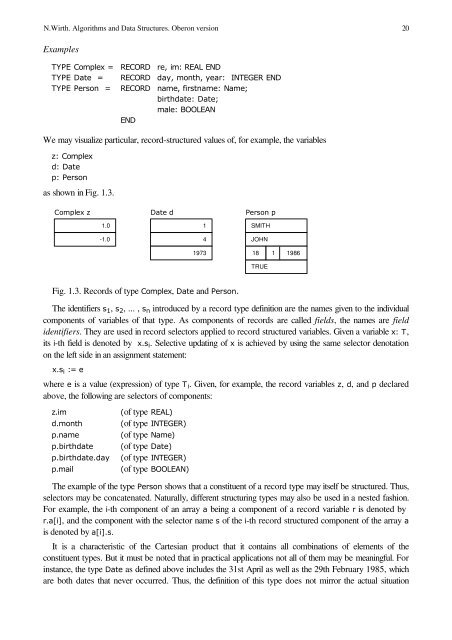Algorithms and Data Structures
Algorithms and Data Structures
Algorithms and Data Structures
Create successful ePaper yourself
Turn your PDF publications into a flip-book with our unique Google optimized e-Paper software.
N.Wirth. <strong>Algorithms</strong> <strong>and</strong> <strong>Data</strong> <strong>Structures</strong>. Oberon version 20<br />
Examples<br />
TYPE Complex = RECORD re, im: REAL END<br />
TYPE Date = RECORD day, month, year: INTEGER END<br />
TYPE Person = RECORD name, firstname: Name;<br />
birthdate: Date;<br />
male: BOOLEAN<br />
END<br />
We may visualize particular, record-structured values of, for example, the variables<br />
z: Complex<br />
d: Date<br />
p: Person<br />
as shown in Fig. 1.3.<br />
Complex z<br />
Date d<br />
Person p<br />
1.0<br />
-1.0<br />
1<br />
4<br />
1973<br />
SMITH<br />
JOHN<br />
18 1 1986<br />
TRUE<br />
Fig. 1.3. Records of type Complex, Date <strong>and</strong> Person.<br />
The identifiers s 1 , s 2 , ... , s n introduced by a record type definition are the names given to the individual<br />
components of variables of that type. As components of records are called fields, the names are field<br />
identifiers. They are used in record selectors applied to record structured variables. Given a variable x: T,<br />
its i-th field is denoted by x.s i . Selective updating of x is achieved by using the same selector denotation<br />
on the left side in an assignment statement:<br />
x.s i := e<br />
where e is a value (expression) of type T i . Given, for example, the record variables z, d, <strong>and</strong> p declared<br />
above, the following are selectors of components:<br />
z.im<br />
d.month<br />
p.name<br />
p.birthdate<br />
p.birthdate.day<br />
p.mail<br />
(of type REAL)<br />
(of type INTEGER)<br />
(of type Name)<br />
(of type Date)<br />
(of type INTEGER)<br />
(of type BOOLEAN)<br />
The example of the type Person shows that a constituent of a record type may itself be structured. Thus,<br />
selectors may be concatenated. Naturally, different structuring types may also be used in a nested fashion.<br />
For example, the i-th component of an array a being a component of a record variable r is denoted by<br />
r.a[i], <strong>and</strong> the component with the selector name s of the i-th record structured component of the array a<br />
is denoted by a[i].s.<br />
It is a characteristic of the Cartesian product that it contains all combinations of elements of the<br />
constituent types. But it must be noted that in practical applications not all of them may be meaningful. For<br />
instance, the type Date as defined above includes the 31st April as well as the 29th February 1985, which<br />
are both dates that never occurred. Thus, the definition of this type does not mirror the actual situation
















